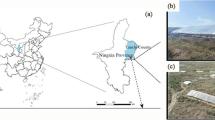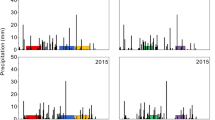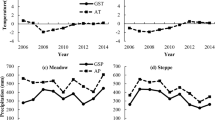Abstract
Changing precipitation regimes can profoundly affect plant growth in terrestrial ecosystems, especially in arid and semi-arid regions. However, how changing precipitation, especially extreme precipitation events, alters plant diversity and community composition is still poorly understood. A 3-year field manipulative experiment with seven precipitation treatments, including − 60%, − 40%, − 20%, 0% (as a control), + 20%, + 40%, and + 60% of ambient growing-season precipitation, was conducted in a semi-arid steppe in the Mongolian Plateau. Results showed total plant community cover and forb cover were enhanced with increased precipitation and reduced under decreased precipitation, whereas grass cover was suppressed under the − 60% treatment only. Plant community and grass species richness were reduced by the − 60% treatment only. Moreover, our results demonstrated that total plant community cover was more sensitive to decreased than increased precipitation under normal and extreme precipitation change, and species richness was more sensitive to decreased than increased precipitation under extreme precipitation change. The community composition and low field water holding capacity may drive this asymmetric response. Accumulated changes in community cover may eventually lead to changes in species richness. However, compared to control, Shannon–Weiner index (H) did not respond to any precipitation treatment, and Pielou’s evenness index (E) was reduced under the + 60% treatment across the 3 year, but not in each year. Thus, the findings suggest that plant biodiversity in the semi-arid steppe may have a strong resistance to precipitation pattern changes through adjusting its composition in a short term.





Similar content being viewed by others
References
Adler PB, Levine JM (2007) Contrasting relationships between precipitation and species richness in space and time. Oikos 116:221–232. https://doi.org/10.1111/j.0030-1299.2007.15327.x
Báez S, Collins SL, Pockman WT, Johnson JE, Small EE (2012) Effects of experimental rainfall manipulations on Chihuahuan desert grassland and shrubland plant communities. Oecologia 172:1117–1127. https://doi.org/10.1007/s00442-012-2552-0
Bai YF, Wu JG, Xing Q, Pan QM, Huang JH, Yang DL, Han XG (2008) Primary production and rain use efficiency across a precipitation gradient on the Mongolia plateau. Ecology 89:2140–2153. https://doi.org/10.1890/07-0992.1
Bodner GS, Robles MD (2017) Enduring a decade of drought: patterns and drivers of vegetation change in a semi-arid grassland. J Arid Environ 136:1–14. https://doi.org/10.1016/j.jaridenv.2016.09.002
Bollig C, Feller U (2014) Impacts of drought stress on water relations and carbon assimilation in grassland species at different altitudes. Agric Ecosyst Environ 188:212–220. https://doi.org/10.1016/j.agee.2014.02.034
Chen H, Ma L, Xin X, Liu J, Wang R (2018) Plant community responses to increased precipitation and belowground litter addition: evidence from a 5-year semiarid grassland experiment. Ecol Evol 8:4587–4597. https://doi.org/10.1002/ece3.4012
Cleland EE, Chiariello NR, Loarie SR, Mooney HA, Field CB (2006) Diverse responses of phenology to global changes in a grassland ecosystem. Proc Natl Acad Sci USA 103:13740–13744. https://doi.org/10.1073/pnas.0600815103
Copeland SM, Harrison SP, Latimer AM, Damschen EI, Eskelinen AM, Fernandez-Going B, Spasojevic MJ, Anacker BL, Thorne JH (2016) Ecological effects of extreme drought on Californian herbaceous plant communities. Ecol Monogr 86:295–311. https://doi.org/10.1002/ecm.1218
De Boeck HJ, Dreesen FE, Janssens IA, Nijs I (2011) Whole-system responses of experimental plant communities to climate extremes imposed in different seasons. New Phytol 189:806–817. https://doi.org/10.1111/j.1469-8137.2010.03515.x
Deng Q, Aras S, Yu CL, Dzantor EK, Fay PA, Luo YQ, Shen WJ, Hui DF (2017) Effects of precipitation changes on aboveground net primary production and soil respiration in a switchgrass field. Agric Ecosyst Environ 248:29–37. https://doi.org/10.1016/j.agee.2017.07.023
Epstein HE, Lauenroth WK, Burke IC (1997) Effects of temperature and soil texture on ANPP in the US Great Plains. Ecology 78:2628–2631
Fay PA, Carlisle JD, Knapp AK, Blair JM, Collins SL (2003) Productivity responses to altered rainfall patterns in a C4 -dominated grassland. Oecologia 137:245–251. https://doi.org/10.1007/s00442-003-1331-3
Felton AJ, Zavislan-Pullaro S, Smith MD (2019) Semiarid ecosystem sensitivity to precipitation extremes: weak evidence for vegetation constraints. Ecology 100:e02572. https://doi.org/10.1002/ecy.2572
Fu G, Shen Z, Zhang X (2018) Increased precipitation has stronger effects on plant production of an alpine meadow than does experimental warming in the Northern Tibetan Plateau. Agric For Meteorol 249:11–21. https://doi.org/10.1016/j.agrformet.2017.11.017
Gherardi LA, Sala OE (2015) Enhanced precipitation variability decreases grass- and increases shrub-productivity. Proc Natl Acad Sci USA 112:12735–12740. https://doi.org/10.1073/pnas.1506433112
Hsu JS, Powell J, Adler PB (2012) Sensitivity of mean annual primary production to precipitation. Glob Chang Biol 18:2246–2255. https://doi.org/10.1111/j.1365-2486.2012.02687.x
Hui D, Jackson RB (2006) Geographical and interannual variability in biomass partitioning in grassland ecosystems: a synthesis of field data. New Phytol 169:85–93. https://doi.org/10.1111/j.1469-8137.2005.01569.x
Huxman TE, Smith MD, Fay PA, Knapp AK, Shaw MR, Loik ME, Smith SD, Tissue DT, Zak JC, Weltzin JF (2004) Convergence across biomes to a common rain-use efficiency. Nature 429:651–654. https://doi.org/10.1038/nature02561
IPCC (2013) The physical science basis. Contribution of working group I to the fifth assessment report of the intergovernmental panel on climate change. Cambridge University Press, Cambridge
Jobbágy EG, Sala OE (2000) Controls of grass and shrub aboveground production in the patagonian steppe. Ecol Appl 10:541–549
Jost L (2006) Entropy and diversity. Oikos 113:363–375. https://doi.org/10.1111/j.2006.0030-1299.14714.x
Knapp AK, Briggs JM, Koelliker JK (2001) Frequency and extent of water limitation to primary production in a Mesic temperate grassland. Ecosystems 4:19–28. https://doi.org/10.1007/s100210000057
Knapp AK, Fay PA, Blair JM, Collins SL, Smith MD, Carlisle JD, Harper CW, Danner BT, Lett MS, McCarron JK (2002) Rainfall variability, carbon cycling, and plant species diversity in a mesic grassland. Science 298:2202–2205. https://doi.org/10.1126/science.1076347
Knapp AK, Beier C, Briske DD, Classen AT, Luo YQ, Reichstein M, Smith MD, Smith SD, Bell JE, Fay PA (2008) Consequences of more extreme precipitation regimes for terrestrial ecosystems. Bioscience 58:811–821. https://doi.org/10.1641/B580908
Knapp AK, Ciais P, Smith MD (2017) Reconciling inconsistencies in precipitation-productivity relationships: implications for climate change. New Phytol 214:41–47. https://doi.org/10.1111/nph.14381
La Pierre KJ, Blumenthal DM, Brown CS, Klein JA, Smith MD (2016) Drivers of variation in aboveground net primary productivity and plant community composition differ across a broad precipitation gradient. Ecosystems 19:521–533. https://doi.org/10.1007/s10021-015-9949-7
Ladwig LM, Collins SL, Swann AL, Xia Y, Allen MF, Allen EB (2012) Above- and belowground responses to nitrogen addition in a Chihuahuan desert grassland. Oecologia 169:177–185. https://doi.org/10.1007/s00442-011-2173-z
Liu H, Mi Z, Lin L, Wang Y, Zhang Z, Zhang F, Wang H, Liu L, Zhu B, Cao G, Zhao X, Sanders NJ, Classen AT, Reich PB, He JS (2018) Shifting plant species composition in response to climate change stabilizes grassland primary production. Proc Natl Acad Sci USA 115:4051–4056. https://doi.org/10.1073/pnas.1700299114
Lloret F, Penuelas J, Estiarte M (2004) Experimental evidence of reduced diversity of seedlings due to climate modification in a Mediterranean-type community. Glob Chang Biol 10:248–258. https://doi.org/10.1111/j.1529-8817.2003.00725.x
Luo Y, Jiang L, Niu S, Zhou X (2017) Nonlinear responses of land ecosystems to variation in precipitation. New Phytol 214:5–7. https://doi.org/10.1111/nph.14476
Miao Y, Han H, Du Y, Zhang Q, Jiang L, Hui D, Wan S (2017) Nonlinear responses of soil respiration to precipitation changes in a semiarid temperate steppe. Sci Rep 7:45782. https://doi.org/10.1038/srep45782
R Core Team (2018) R: a language and environment for statistical computing. R Foundation for Statistical Computing, Vienna, Austria. https://www.r-project.org/
Robertson TR, Bell CW, Zak JC, Tissue DT (2009) Precipitation timing and magnitude differentially affect aboveground annual net primary productivity in three perennial species in a Chihuahuan Desert grassland. New Phytol 181:230–242. https://doi.org/10.1111/j.1469-8137.2008.02643.x
Sala OE, Lauenroth WK, Golluscio RA (1997) Plant functional types in temperate semi-arid regions. In: Smith TM, Shugart HH, Woodward FI (eds) Plant functional types. Cambridge University Press, Cambridge, pp 217–233
Schwinning S, Sala OE (2004) Hierarchy of responses to resource pulses in arid and semi-arid ecosystems. Oecologia 141:211–220. https://doi.org/10.1007/s00442-004-1520-8
Schwinning S, Starr BI, Ehleringer JR (2005) Summer and winter drought in a cold desert ecosystem (Colorado Plateau) part II: effects on plant carbon assimilation and growth. J Arid Environ 61:61–78. https://doi.org/10.1016/j.jaridenv.2004.07.013
Sherry RA, Arnone JA, Johnson DW, Schimel DS, Verburg PS, Luo Y (2011) Carry over from previous year environmental conditions alters dominance hierarchy in a prairie plant community. J Plant Ecol 5:134–146. https://doi.org/10.1093/jpe/rtr028
Shi Z, Lin Y, Wilcox KR, Souza L, Jiang L, Jiang J, Jung CG, Xu X, Yuan M, Guo X, Wu L, Zhou J, Luo Y (2018) Successional change in species composition alters climate sensitivity of grassland productivity. Glob Chang Biol 24:4993–5003. https://doi.org/10.1111/gcb.14333
Smith MD, Knapp AK (2003) Dominant species maintain ecosystem function with non-random species loss. Ecol Lett 6:509–517. https://doi.org/10.1046/j.1461-0248.2003.00454.x
Smith MD, Wilcox KR, Power SAD, Tissue T, Knapp AK (2017) Assessing community and ecosystem sensitivity to climate change–toward a more comparative approach. J Veg Sci 28:235–237. https://doi.org/10.1111/jvs.12524
Solomon S, Plattner G-K, Knutti R, Friedlingstein P (2009) Irreversible climate change due to carbon dioxide emissions. Proc Natl Acad Sci USA 106:1704–1709
Storch D, Bohdalkova E, Okie J (2018) The more-individuals hypothesis revisited: the role of community abundance in species richness regulation and the productivity-diversity relationship. Ecol Lett 21:920–937. https://doi.org/10.1111/ele.12941
Wilcox KR, von Fischer JC, Muscha JM, Petersen MK, Knapp AK (2015) Contrasting above- and belowground sensitivity of three Great Plains grasslands to altered rainfall regimes. Glob Chang Biol 21:335–344. https://doi.org/10.1111/gcb.12673
Wilcox KR, Shi Z, Gherardi LA, Lemoine NP, Koerner SE, Hoover DL, Bork E, Byrne KM, Cahill JJ, Collins SL et al (2017) Asymmetric responses of primary productivity to precipitation extremes: a synthesis of grassland precipitation manipulation experiments. Glob Chang Biol 23:4376–4385. https://doi.org/10.1111/gcb.13706
Wu Z, Dijkstra P, Koch GW, PeÑUelas J, Hungate BA (2011) Responses of terrestrial ecosystems to temperature and precipitation change: a meta-analysis of experimental manipulation. Glob Chang Biol 17:927–942. https://doi.org/10.1111/j.1365-2486.2010.02302.x
Wu D, Ciais P, Viovy N, Knapp AK, Wilcox K, Bahn M, Smith MD, Vicca S, Fatichi S, Zscheischler J et al (2018a) Asymmetric responses of primary productivity to altered precipitation simulated by ecosystem models across three long-term grassland sites. Biogeosciences 15:3421–3437. https://doi.org/10.5194/bg-15-3421-2018
Wu X, Liu H, Li X, Ciais P, Babst F, Guo W, Zhang C, Magliulo V, Pavelka M, Liu S, Huang Y, Wang P, Shi C, Ma Y (2018b) Differentiating drought legacy effects on vegetation growth over the temperate Northern Hemisphere. Glob Chang Biol 24:504–516. https://doi.org/10.1111/gcb.13920
Xia Y, Moore DI, Collins SL, Muldavin EH (2010) Aboveground production and species richness of annuals in Chihuahuan Desert grassland and shrubland plant communities. J Arid Environ 74:378–385. https://doi.org/10.1016/j.jaridenv.2009.08.016
Xu Z, Wan S, Ren H, Han X, Li MH, Cheng W, Jiang Y (2012) Effects of water and nitrogen addition on species turnover in temperate grasslands in northern China. PLoS One 7:e39762. https://doi.org/10.1371/journal.pone.0039762
Yahdjian L, Sala OE (2002) A rainout shelter design for intercepting different amounts of rainfall. Oecologia 133:95–101. https://doi.org/10.1007/s00442-002-1024-3
Yang H, Li Y, Wu M, Zhang Z, Li L, Wan S (2011a) Plant community responses to nitrogen addition and increased precipitation: the importance of water availability and species traits. Glob Chang Biol 17:2936–2944. https://doi.org/10.1111/j.1365-2486.2011.02423.x
Yang H, Wu M, Liu W, Zhang Z, Zhang N, Wan S (2011b) Community structure and composition in response to climate change in a temperate steppe. Glob Chang Biol 17:452–465. https://doi.org/10.1111/j.1365-2486.2010.02253.x
Yang H, Jiang L, Li L, Li A, Wu M, Wan S (2012) Diversity-dependent stability under mowing and nutrient addition: evidence from a 7-year grassland experiment. Ecol Lett 15:619–626. https://doi.org/10.1111/j.1461-0248.2012.01778.x
Yang X, Yang ZL, Tan JQ, Li GY, Wan SQ, Jiang L, Shefferson R (2018) Nitrogen fertilization, not water addition, alters plant phylogenetic community structure in a semi-arid steppe. J Ecol 106:991–1000. https://doi.org/10.1111/1365-2745.12893
Ye JS, Pei JY, Fang C (2018) Under which climate and soil conditions the plant productivity-precipitation relationship is linear or nonlinear? Sci Total Environ 616–617:1174–1180. https://doi.org/10.1016/j.scitotenv.2017.10.203
Zeppel MJ, Adams HD, Anderegg WR (2011) Mechanistic causes of tree drought mortality: recent results, unresolved questions and future research needs. New Phytol 192:800–803. https://doi.org/10.1111/j.1469-8137.2011.03960.x
Zeppel MJB, Wilks JV, Lewis JD (2014) Impacts of extreme precipitation and seasonal changes in precipitation on plants. Biogeosciences 11:3083–3093. https://doi.org/10.5194/bg-11-3083-2014
Zhang B, Zhu JJ, Pan QM, Liu YS, Chen SP, Chen DM, Yan Y, Dou SD, Han XG (2017a) Grassland species respond differently to altered precipitation amount and pattern. Environ Exp Bot 137:166–176. https://doi.org/10.1016/j.envexpbot.2017.02.006
Zhang FY, Quan Q, Song B, Sun J, Chen YJ, Zhou QP, Niu SL (2017b) Net primary productivity and its partitioning in response to precipitation gradient in an alpine meadow. Sci Rep 7:15193. https://doi.org/10.1038/s41598-017-15580-6
Zhang L, Xie Z, Zhao R, Zhang Y (2018) Plant, microbial community and soil property responses to an experimental precipitation gradient in a desert grassland. Appl Soil Ecol 127:87–95. https://doi.org/10.1016/j.apsoil.2018.02.005
Zhao C, Yuan M, Yu CD, Zhu LL, Wang F, Jiang L, Hui DF, Wan SQ (2016) Soil microbial community composition and respiration along an experimental precipitation gradient in a semiarid steppe. Sci Rep 6:24317. https://doi.org/10.1038/srep24317
Acknowledgements
The authors thank Qian Zhang, Hongyan Han, and Fanglong Su for their help in the field experiments.
Funding
This study was funded by the National Natural Science Foundation of China (31430015 and 31830012).
Author information
Authors and Affiliations
Contributions
MXZ and SW conceived the ideas and designed methodology; MXZ, YM, AZ, ZZ, JR, MMZ, YL collected the data; MXZ and SW analyzed the data; MXZ, DH, and SW led the writing of the manuscript. All authors contributed critically to the drafts and gave final approval for publication.
Corresponding author
Ethics declarations
Conflict of interest
The authors declare that they have no conflict of interest.
Additional information
Communicated by Brian J. Wilsey.
Electronic supplementary material
Below is the link to the electronic supplementary material.
Rights and permissions
About this article
Cite this article
Zhong, M., Song, J., Zhou, Z. et al. Asymmetric responses of plant community structure and composition to precipitation variabilities in a semi-arid steppe. Oecologia 191, 697–708 (2019). https://doi.org/10.1007/s00442-019-04520-y
Received:
Accepted:
Published:
Issue Date:
DOI: https://doi.org/10.1007/s00442-019-04520-y




